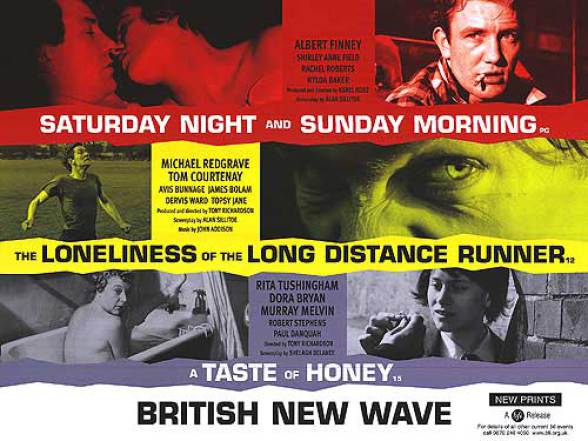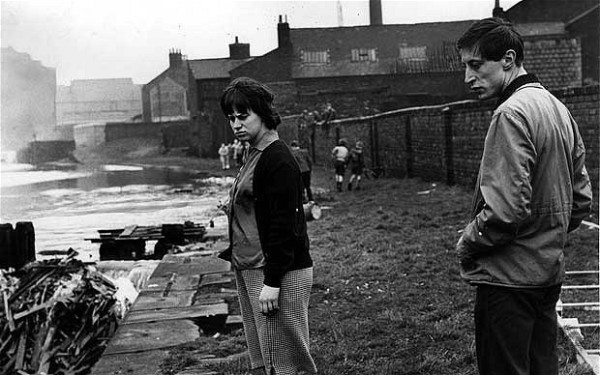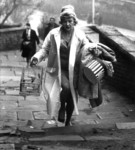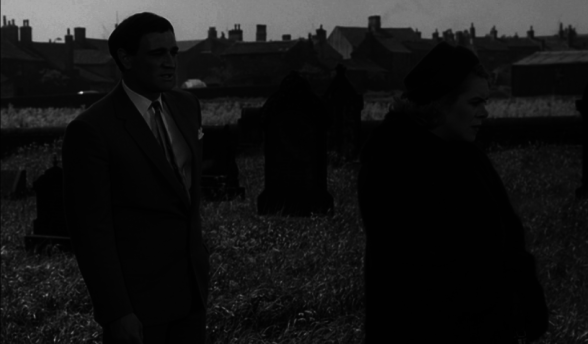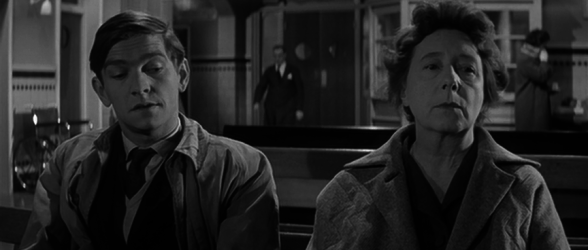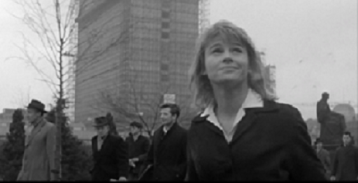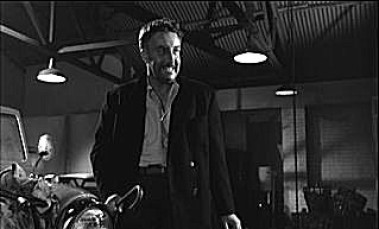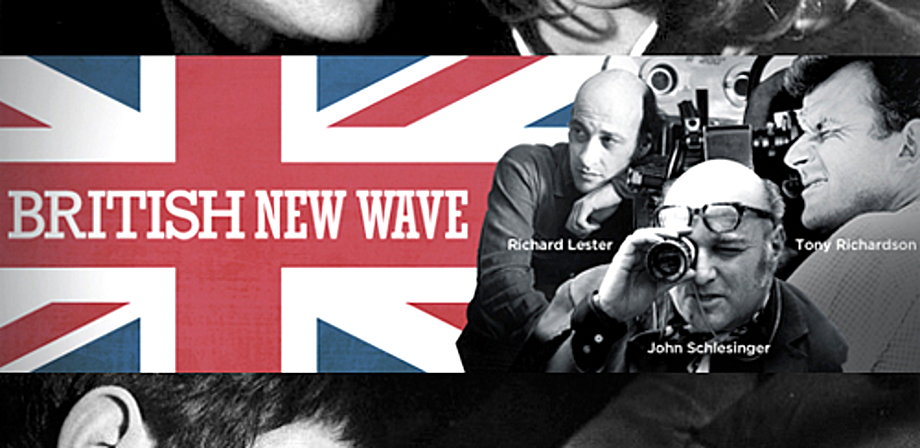
THE BRITISH NEW WAVE 1958 - 1963
It was common practice when I was at school/college - perhaps it still is - to always start off your essay by saying that you needed to define what was meant by X; it was a good way to start writing rather than stare at a blank piece of paper. I don't need to do that any more - I don't seem to have trouble writing enough words these days, just the opposite - but I still think it's worth starting off with some kind of definition of so-called Kitchen Sink films, or New Wave films, as they do seem to be all things to all people.
Rather like film noir, the cateogry is sometimes endlessly expanded; there was a two minute taster on youtube for a 15 minute piece there entitled 'British New Wave Cinema of the 1960s', both of which have since been removed since so I can't post them here, but their definition goes on to include If...(1968) and Swinging London films such as Alfie and The Knack...and how to get it. Everyone is entitled to their opinion of course, and good luck to them (and it was a nicely put together piece) but on this page I've just taken these films to mean those between 1958 and 1963 (for reasons which I'll go on to) and defined my parameters rather more narrowly.
The film canon
So what to include? Here's a timeline of the films that are usually included, along with the dates of the source book or play and when they were first published or performed.
| Year | Play/book | Film |
| 1956 |
Look Back In Anger (play) | |
| 1957 |
Room at the Top (novel) The Entertainer (play) |
|
| 1958 |
Saturday Night and Sunday Morning (novel) A Taste of Honey (play) |
|
| 1959 |
Billy Liar (novel) The Loneliness of the Long Distance Runner (short story) |
Room at the Top Look Back In Anger |
| 1960 |
A Kind of Loving (novel) This Sporting Life (novel) Billy Liar (play) The L-Shaped Room (novel) |
The Entertainer Saturday Night and Sunday Morning |
| 1961 |
A Taste of Honey |
|
| 1962 |
A Kind of Loving The Loneliness of the Long Distance Runner The L-Shaped Room |
|
| 1963 |
Billy Liar This Sporting Life |
Set out in this fashion, a number of things become a bit clearer. Firstly, all the so-called New Wave films have literary antecedents, but, more noticeably, very recent literary antecedents (the normal gap between publication/first production and film release is 2-3 years); secondly, the literary impetus had run its course by 1960; and thirdly, the first film (Room at the Top, right) was in 1959, the last (what I mean by that I'll come on to) in 1963 - four short years.
The first film of the cycle, Room at the Top, looks at class and how it can be a barrier to success. I've now written about this film at length in the book-to-film section of the website (see Room at the Top) so I'll just show a short scene here, which raises the curtain on the New Wave films by introducing Joe Lampton as he arrives in Warnley (actually Halifax train station):
So what's the connection? Why include these films and not others? There's only 10 films listed above; I've read dozens of articles on these films, and those ones are always mentioned. Firstly, I suppose there's an element of the 'canonical' about them - like film noir, what films simply have to be in there? On that basis you have to have, as a bare minimum, Saturday Night and Sunday Morning, Room at the Top, A Kind of Loving, A Taste of Honey, The Loneliness of the Long Distance Runner and This Sporting Lilfe. That leaves the two John Osborne play adaptations (Look Back In Anger and The Entertainer) which normally get included (they are in Robert Murphy's chapter on this area of filmmaking in his book, and see below on Peter Hutchings' article) but I'll be honest and admit that I don't know these films very well, simply because they don't appeal to me, perhaps because I don't as a rule of thumb like films adapted from plays; in fact, I'm not sure that I've even seen Look Back in Anger properly...
Billy Liar is, for me, a very different film, that needs to be discussed more as a precursor to Swinging London films (see below), and The L-Shaped Room rarely gets included as a New Wave film, perhaps because it's set in London.
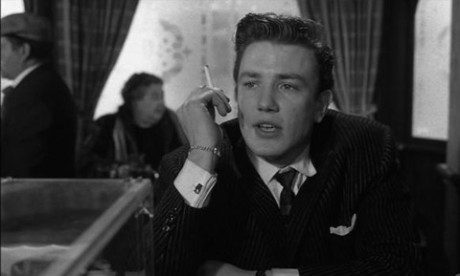 Albert Finney in Saturday Night and Sunday Morning - "whatever people say I am, that's what I'm not"
Albert Finney in Saturday Night and Sunday Morning - "whatever people say I am, that's what I'm not"
I can't remember a time when I didn't love these films. I'm not sure whether I first saw Saturday Night and Sunday Morning on the TV or at the cinema, but I do remember seeing it at the Watershed in Bristol in December 1984 during my first year at college, and thinking what a great film it was; I haven't changed my mind over 30 years later. I showed it as one of 10 films in a British 60s cinema 'season' as part of a film club I ran in Abu Dhabi a few years ago, and it was generally regarded as the best of the 10.
I remember searching them all out (bear in mind this was long before the days of Netflix, Lovefilm, downloads and Sky movie channels) and wanting to read more about them and learn about the people that made them; it's probably no exaggeration to say that they started my passion for British films.
Key characters
In many respects it's quite irritating that these films get lumped together, as it often only serves to hide how different they are, and the different themes and issues they explore. One of the biggest differences for me lies in the representation of the main characters and their attitudes to life. The character who started it all off in a way, Joe Lampton in Room at the Top, is the archetypal go-getter, ambitious for life's material rewards in terms of house, cars, women and clothes (not necessarily in that order), without being servile in any way, whilst Arthur Seaton in Saturday Night and Sunday Morning couldn't give a damn about 'getting on', in fact he rails against such an idea right at the very start of the film: "What I'm out for is a good time, all the rest is propaganda." Some of his comments might suggest that he would be hard left, maybe even Communist, but he would probably laugh in contempt at the thought; as he again himself says "Whatever people say I am, that's what I'm not".
Colin Smith in The Loneliness of the Long Distance Runner perhaps comes closest to the young Bolshevik, in his speeches on what he would like to do to all the bosses (put them against the wall and shoot them) but he is hardly representative of the working class, being a petty criminal who doesn't seem to have a job or indeed want one.
One character who certainly isn't an Angry Young Man is Vic Brown in A Kind of Loving, whose very ordinariness is sometimes painful. As a draughtsman he is a social class or two above Arthur Seaton and Colin Smith, maybe Joe Lampton too, and whilst not overly ambitious he does sense that there's more to life than what he has at the moment, before having to settle for married life once Ingrid is pregnant. Frank Machin is probably the nearest character to Arthur Seaton - it would not be too much of a stretch of the imagination to imagine them having a beer together, whereas that scenario is pretty unlikely with any of the other main New Wave characters - yet even there Machin knows what he wants in terms of money (which he immediately uses to buy a car, hard to imagine Seaton caring about a car if he came into some money) even if he is rather confused and uncertain in other areas of life.
And of course the only main female character in the New Wave films, Jo in A Taste of Honey, seems to have no plans or ambitions at all, and remains probably the most enigmatic and hard to read character of them all, possibly as she was created in a play rather than a novel, so that her thoughts only come across in dialogue, whereas all the others came from novels, often written in the first person.
Unwanted pregnancies
One common theme that runs through some of the key films is an unwanted pregnancy; in the days before the Abortion Act 1967 it was illegal to bring on an abortion, and this often features in the film narratives, either in terms of a hastily arranged marriage (A Kind of Loving, Room at the Top), a general theme (A Taste of Honey) or indeed an abortion, as in Saturday Night and Sunday Morning (and featured again in both TV and film versions of Up the Junction):
Shelagh Delaney's play took a different approach, although admittedly Jo (Rita Tushingham) doesn't have the worry about being married and having a child by another man. A wilful, naive but determined teenager, Jo has had a brief liasion with a black sailor, Jimmy (played by Paul Danquah in the film) who has moved on without even knowing that she's pregnant, but her new friend Geoffrey (Murray Melvin), whom she meets in the shoe shop where she works, has read the signs....This clip splices together two scenes from different parts of the film:
The usual way however, particularly given the legal restrictions on abortion and the social ignominy of being an unmarried mother, was for the couple to get married, as happens in Room at the Top and in A Kind of Loving, where it forms the central, key theme of the film. In this scene Vic Brown (Alan Bates), after a brief off-and-on relationship with Ingrid Rothwell (June Ritchie), finds out that the consequences are going to be long lasting:
Locations
One definite common theme in these films is that they are all set in the Midlands/the North - not such a radical idea these days, but it was then, when most films were set in London and/or studio bound. Here's a breakdown of where each film was filmed:
| Film | Setting |
| Room at the Top | Halifax, Bradford |
| The Entertainer | Morecambe |
| Saturday Night and Sunday Morning | Nottingham |
| A Taste of Honey | Stockport, Salford, Manchester, Blackpool |
| A Kind of Loving | Preston, Bolton etc (some disagreement over some locations) |
| The Loneliness of the Long Distance Runner | Nottingham (but also London and Camber Sands) |
| Billy Liar | Bradford, Leeds |
| This Sporting Life | Halifax, Wakefield |
If you add in films which are not usually included in the New Wave, such as Whistle down the Wind (filmed in Pendle Hill and Clitheroe, Lancashire) and Hell is A City (Manchester), it's clear that in a short space of time there was a lot of filming in industrial Northern locations, here's a photo gallery of some of the shots from said films:
There's been a bit of a dispute about the location of the bridge that Alan Bates walks over in the shot above in A Kind of Loving; but I have it now on good authority from Peter Ogden and Jeremy Sutcliffe, who have both been in touch, that it is the Gas St Bridge in Oldham (not in Bolton, as was suggested elsewhere). The best source is easily www.reelstreets.com, so here's the link for each film on their website:
Room at the Top: http://www.reelstreets.com/films/room-at-the-top/
Saturday Night and Sunday Morning: http://www.reelstreets.com/films/saturday-night-and-sunday-morning/
A Taste of Honey: http://www.reelstreets.com/films/taste-of-honey-a/
A Kind of Loving: http://www.reelstreets.com/films/kind-of-loving-a/
The Loneliness of the Long Distance Runner: http://www.reelstreets.com/films/loneliness-of-a-long-distance-runner-the/
This Sporting Life: http://www.reelstreets.com/films/this-sporting-life/
and for good measure, Billy Liar: http://www.reelstreets.com/films/this-sporting-life/
Tony Richardson once said, in an interview in 1960, that:
"I hate studios. I no longer want to shoot even interiors in a studio, I would rather work in the limited conditions which a location imposes on you. For the sort of realistic films I want to make, by improvising one's way out of the impossibilities of real conditions you get something on the screen that is more true, somehow, than something contrived on a set....once inside a studio you start taking walls out....One is getting in fact less of the human reality."
This Sporting Life (1963)
This Sporting Life was the last of the New Wave films, coming out in Feb 1963; but by the time it came out it had missed the boat, and was a box office failure. John Davis, of the Rank organisation, even went so far as to decide to never make such films again, calling instead for films to be entertainment first and foremost.
It's not a film I've ever much cared for, in fact until recently I hadn't seen it properly for about 20 years, but in a way it's the 'Kitchen Sink' film that all the others were meant to resemble; dour, depressing, gritty and uncompromising. Adapted from David Storey's novel, it tells the story, mainly in flashback, of Frank Machin (called Arthur Machin in the book, it was changed as the producers felt it sounded too much like Arthur Seaton), a miner turned rugby league player who rents a room from Mrs Hammond (Rachel Roberts) whom he eventually has an affair of sorts with. In this sequence Machin negotiates a fantastic signing on deal with the local club, only to find that, predictably, Mrs Hammond is not impressed:
Some have argued that This Sporting Life was the best of the New Wave films, but it's not an opinion I share, in fact it's my least favourite of all the films. Six months later Billy Liar was released, which although it often gets lumped in with the New Wave films, in fact was marketed very differently to the others and it turned out to be a pivotal 'bridging point' between the Northern films and those that were to make up the Swinging London films.
Billy Liar (1963)
Billy Liar, released in August 1963 and adapted from the Keith Waterhouse and Willis Hall book and then play, is usually placed in with the other New Wave films, but it is really a bridge between them and the so-called Swinging London films of the mid-Sixties, particularly with regard to its ending (see below). This trailer shows how differently the film was marketed, as a comedy - note the caption "truly hilarious adventures" :
The film also introduced a very important kind of character, which had rarely been seen before in British films, and certainly not in the New Wave films, filled with downtrodden and repressed women like Mrs Hammond, Ingrid and Brenda: the footloose and fancy-free young woman represented by Julie Christie's character Liz. These images of Julie Christe swinging her handbag also seem to literally start the Swinging Sixties, although I can't help noticing that of all the places she supposedly just flits off to, her last port of call was not Paris, Cannes or even London...but Doncaster:
Julie Christie's character Liz represents the reality to place alongside Billy's fantasy world; he really can go to London, he really can pursue his dreams (although there is little evidence that he has any talent, apart from having co-written a song which is performed at the local dance hall), but the big queston is - has he got the bottle to do so? Egged on and encouraged by Liz, he decides to leave that very night on a train to London with her, despite the death of his grandmother, but I think even the first time I saw the film I knew that he never would:
Billy goes home, and back to his comforting, fantasy world, whilst Julie Christe herself went on to play Diana Scott in the seminal Swinging London film Darling, light years away from the gritty North. I've now written at length about the adaptation of the novel into the film version of Billy Liar on this site here: Billy Liar
Beyond the New Wave
As I grew older and learnt much more about these films, they were often presented as a group or set of films that were in direct contrast to the staid and dull 50s. There is an element of truth in that, to be fair, but the conventional reading of British film history (basically: 30s - pre-history, 40s - war films, Ealing and David Lean, 50s - dull, 60s - New Wave and Swinging London, 70s - rubbish, 80s - renaissance) is so restrictive that it is amazing how long its basic elements have remained in place.
About 6-7 years ago I read an article by Peter Hutchings (a Professor at Northumbria University) called 'Beyond the New Wave: Realism in British Cinema, 1959-1963' which has greatly influenced me (it's in 'The British Cinema Book' edited by Robert Murphy). In it he argues that 'realism' was deployed in these key years across a much greater range of types and genres than is usually noted, citing such films as Never Let Go, The Angry Silence, The Damned, The Frightened City and Beat Girl, amongst many others (all of the aforementioned are films I'd like to write about on this website in the future, probably on the 'Unsung films' pages - in fact I've just written a page on Never Let Go [June 14]). This idea fits in very much with the view I've come to independently, that the New Wave films need to be seen in a wider context than has been the case in the past. If I get asked to give another talk on aspects of British cinema, I wouldn't mind looking at 'realistic' New Wave crime films, like The Frightened City, Hell Drivers, Offbeat, and The Informers.
One of the reasons the New Wave films were so popular (Saturday Night and Sunday Morning broke all box-office records at the time, for example, with queues going round the block at its West End cinema) is the strong anti-establishment attitude of many of the central protagonists (for example, see the speech by Tom Courtenay in the trailer for Loneliness... below), none more so than Finney as Arthur Seaton in Saturday Night and Sunday Morning. The famous start must have been quite startling for those used to forelock-tugging know-your-place workers:
It's interesting to note that while many of the film makers themselves were often very different in outlook (and as many have pointed out, individual directors often made very different films, Tony Richardson being a case in point) the production companies played on the perceived similarities and marketed them with direct reference to previous films in the 'series'. For example, look at this trailer for The Loneliness of the Long Distance Runner and see how it is marketed in relation to previous works by both its writer and its director:
It's Grim Up North
There are clearly enough similarities in the films for them to be open to parody, and Harry Enfield's South Bank Show with Melvyn Bragg from 1989 - 'Sir Norbert Smith: a Life' - did it better than anyone. Here's a clip from the programme, with Sir Norbert (surely a direct reference to Sir Laurence Olivier at this point?) appearing in the 1962 Kitchen Sink film 'It's Grim up North' - mainly Saturday Night and Sunday Morning but with a bit of Kes thrown in. Brilliant.
The impact of these films has been debated endlessly over the years, and whilst their influence has probably been over-emphasised - when all's said and done, they amount to no more than 10 films at most over a period of 4 years - I don't agree when their impact or influence is sometimes now regarded as negligible. One of the things I love about these films is that they put, centre stage, previously excluded or marginalised groups of people - working class men and women, Northerners, blacks, gays, lesbians, single mothers - in a way which simply didn't happen before, and I don't think that should be overlooked or ignored. And I still love watching them - great films.
